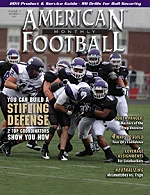AMERICAN FOOTBALL MONTHLY THE #1 RESOURCE FOR FOOTBALL COACHES
|
|
Article Categories
|
TRICKING THE DEFENSE WITH BIG PLAYS© More from this issueBy Marc Sites, Assistant Coach, Liberty High School (CO)
“Watch out, this team is fancy,” said an opposing player to his teammates at one of our games recently.
We had just converted a fake punt on a fourth and two for about a five-yard gain. It wasn’t an unusual play by any standards, but that statement caused me to reflect on the number of trick (or creative) plays I have in my playbook. I realized that for a freshman football playbook, we run several trick plays. Unlike some coaches who also have trick plays in their playbook, I frequently run ours. They are not there to run once or twice in a season - we run a high percentage of ours every game. They are an important part of what we try to accomplish offensively.....The full article can only be seen by subscribers.
Subscribe today!

|
|
|
NOT A SUBSCRIBER?
Subscribe
now to start receiving our monthly magazine PLUS get INSTANT
unlimited access to over 4000 pages of 100 percent football coaching
information, ONLY available at AmericanFootballMonthly.com!
|
|
|
HOME
|
MAGAZINE
|
SUBSCRIBE
|
ONLINE COLUMNISTS
|
COACHING VIDEOS
|
Copyright 2025, AmericanFootballMonthly.com
All Rights Reserved






